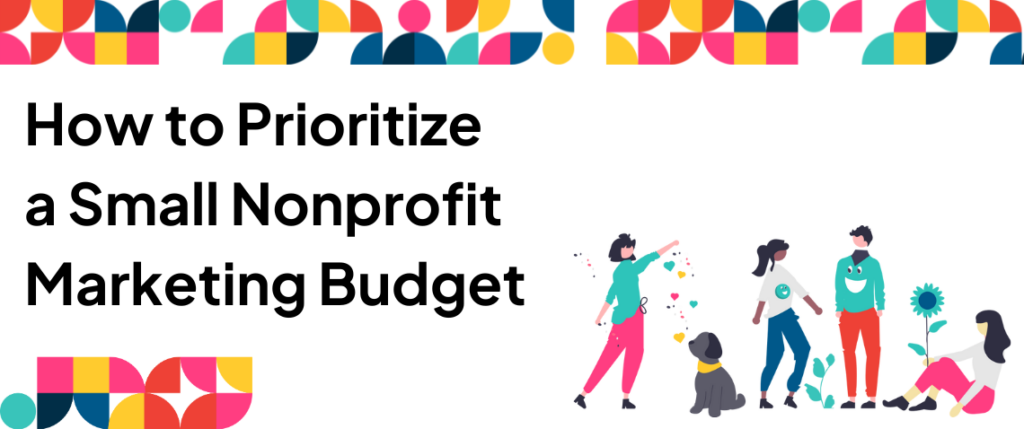Nonprofits often juggle multiple responsibilities, and marketing is one of the first areas to suffer from limited resources—but under-investing in marketing can hinder a nonprofit’s ability to fulfill its mission.
The “the nonprofit starvation cycle,” as identified by the Stanford Social Innovation Review, describes how cutting overhead costs to allocate more money to the mission can ultimately hold an organization back from the resources it needs to succeed.
Determining the right marketing budget for your organization can be challenging, especially when outdated ideas encourage minimal overhead spending. Online charity rating sites have reinforced this idea by equating low overhead with efficiency.
But the truth is more complicated. Read on to find out how much nonprofits should spend on marketing and what areas you should prioritize in your budget.
How Much Should Nonprofits Spend on Marketing?
Any organization can expect to spend somewhere between 5 and 10% of their overall budget on marketing. But how much should yours spend? That depends on the scale of your nonprofit.
If your nonprofit has a budget of $140,000, 5% is just $7,000. But if your nonprofit’s budget is $1 million, 5% is $50,000. That’s a lot more to work with. Smaller organizations may consider spending a larger percentage of their budget on marketing—closer to 10% than 5%.
But instead of focusing on spending no more than a certain percentage, your nonprofit should focus on what specific, measurable goals you want to accomplish. Set your goal, determine how to measure success, and set aside a budget to achieve it.
Top 5 Priorities for a Small Nonprofit Marketing Budget
1. Content Marketing
92% of nonprofit marketers use at least some form of content marketing. It allows you to build relationships, educate your audience, and inspire action through engaging and valuable content.
- Storytelling
Share stories that highlight the impact your nonprofit makes. Use testimonials, case studies, and narratives to connect emotionally with your audience.
- Educational Content
Create blog posts, videos, and infographics that educate your audience about your cause.
- Community Engagement
Leverage user-generated content by encouraging your audience to share their experiences and content related to your cause.
- Content Planning
Develop a content calendar to ensure consistent communication across your platforms. Regular updates keep your audience informed and engaged.
2. Search Engine Optimization (SEO)
26.5% of all web traffic in 2023 came from organic visits, and SEO is the backbone of drawing that organic traffic to your nonprofit’s website. It ensures that your content reaches people who are actively searching for causes like yours.
- Keyword Research
Identify the terms your audience uses when searching for topics related to your mission. Incorporate these keywords naturally into your content to improve visibility.
- On-Page SEO
Optimize your website’s structure, titles, meta descriptions, and headers to ensure search engines understand your content and rank it appropriately.
- Local SEO
Create your Google Business Profile and use location-specific keywords to reach a specific local audience.
- Backlink Building
Collaborate with other organizations, blogs, and media outlets to earn backlinks from reputable sources, boosting your site’s authority and credibility.
3. Email Marketing
Email marketing is one of the most powerful tools for small nonprofits. 26% of donors say that email is the tool that most inspires them to give. Here’s how your organization can utilize it:
- Personalization
Segment your email lists and tailor messages to specific audiences to deliver relevant content to specific groups within your contact list.
- Automation
Set up automated email sequences (drip campaigns) to welcome new supporters and maintain engagement over time.
- Measurable Results
Many email marketing platforms offer detailed analytics, allowing you to track how well your messages perform and make data-driven decisions to improve future campaigns.
4. Pay-Per-Click (PPC) Advertising
PPC advertising is a strategic way to quickly boost your nonprofit’s online visibility.
- Targeting
Use PPC to target specific keywords that align with your mission, while focusing on specific demographics, interests, and behaviours that match your ideal supporters.
- Budget Control
With PPC advertising, you pay only when someone clicks on your ad, ensuring your budget goes towards engaged users.
- Measurable ROI
Utilize tools like Google Ads to track ad performance and understand the impact of your ads on organizational goals like donations or volunteer sign-ups.
- Complement SEO Efforts
Appearing in both sponsored ads and organic search results helps to establish your nonprofit’s brand awareness and credibility.
Through many PPC platforms, like Google Ad Grants, approved organizations can receive a monthly allocation of up to $10,000 to invest in Google Ads, harnessing the power of pay-per-click (PPC) marketing at no or little cost.
5. Organic Social Media
42% of US donors use LinkedIn to research nonprofits to support and 26% discover donation opportunities on LinkedIn. Organic social media is a powerful way to connect with your audience, on platforms like LinkedIn, and build a community around your cause. Here’s how your organization can get its start:
- Platform Selection
Identify where your audience spends most of their time, such as Facebook, Instagram, or LinkedIn, and prioritize those platforms.
- Build Community
Engage with your audience through comments, shares, and direct messages to foster a sense of community and connection.
- Collaborations and Partnerships
Collaborate with influencers, other nonprofits, or community leaders to cross-promote each other’s content and events.
Making the Most of Your Nonprofit Marketing Budget
Maximizing your nonprofit marketing budget requires strategic planning, prioritization, and a willingness to adapt. By focusing on essential areas, nonprofits can effectively reach and engage their audience without overspending.
Remember, marketing isn’t just about promoting your cause—it’s about building lasting relationships.
At The PODvocate Project, we understand the unique challenges nonprofits face, and we’re committed to amplifying their efforts through innovative marketing strategies.
Learn more about The PODvocate Project’s mission and how you can contribute to making a meaningful impact.








